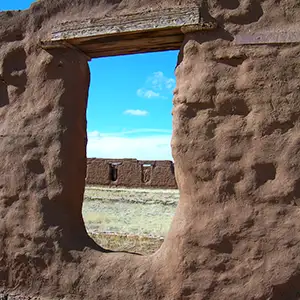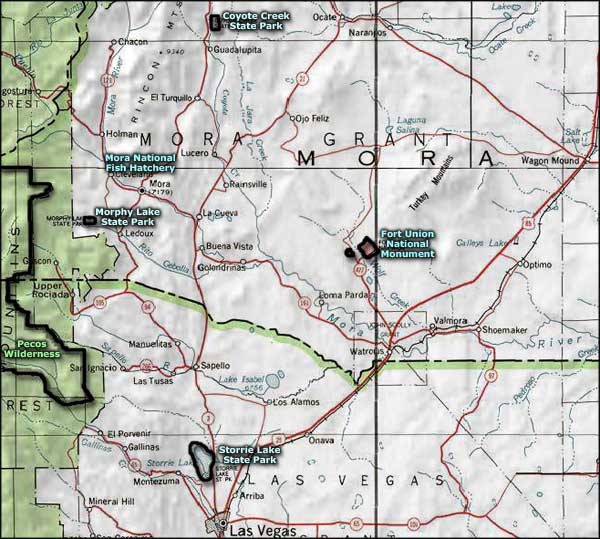Fort Union National Monument

Fort Union National Monument

Looking at what's left standing, it's hard to recognize that Fort Union was once the largest US military installation on the southwestern frontier. These few brick chimneys, melted adobe walls and stone foundations still indicate the grandeur of what was once here. There is a self-guided tour through the Fort with plaques at appropriate intervals to help the visitor to envision what life might have been like for personnel stationed here. One thing is for sure though, most Army wives really didn't like this place. Situated on a barren plain with almost no hope for trees, or even grass, with the mountains 3 miles away and severe dust storms cropping up often, Fort Union's living conditions didn't enjoy the greatest reputation. But then, Fort Union was built here near the junction of the two main branches of the Santa Fe Trail (the Mountain Branch and the Cimarron Cutoff) for a reason: to protect travelers and merchandise from Indian attacks along the Trail.
As you walk through the Fort, you'll see in the distance, across the valley to the west, some old ruins. These ruins are in the area of the first Fort Union but the ruins you see are actually what's left of the Fort Union Ordnance Depot, built in the 1860's (these ruins are not accessible to the public). The first Fort Union was built in 1851 of green timbers, and the buildings were decaying quickly and in constant need of repair. Almost all traces of this first construction have since rotted away. However, the first Fort Union served as a base for military operations and as a key station on the Santa Fe Trail for a decade. Then came the Civil War.
With the beginning of hostilities, most of the regular troops were withdrawn from the frontier posts and they were replaced by volunteer regiments. Planning for a possible Confederate invasion, the second Fort Union was built, beginning in August, 1861 and using over 1,000 men (200 men per shift) working in four-hour shifts around the clock. It was a star-shaped massive earthen fortification with quarters for the officers and the enlisted men and storage for supplies and ordnance built inside. The unbarked pine logs used in parts of its construction rotted and became infested with bugs so quickly that most of the troops refused to live in the damp, infested and unhealthy place, choosing instead to camp out in tents on the prairie around the fort. Colonel John Slough and the 1st Colorado Regiment arrived in March, 1862, and the policy of waiting for the Confederates to advance up the Rio Grande ended. Taking command, Slough organized a force of regulars and volunteers and marched south towards Santa Fe. They met the Confederates and, in a three-day battle, turned them back at Glorieta Pass a few days later. That effectively ended the Confederate threat in the Southwestern Territories.
In 1863, construction of the third Fort Union was begun. It took six years to complete. The final construction contained not just the military post but also a separate quartermaster depot with its own warehouses, shops, corrals, offices and quarters. The supply function of the quartermaster's depot employed more men than the military post and was far more important to the Territory of New Mexico. The Ordnance Depot was built at the same time, across the valley near the remains of the first fort.
By 1867, the garrison was living in the newly constructed adobe quarters of the third Fort Union and the earthwork of the Star Fort had become a haven for prostitutes and drifters. At that time, Post Commander Colonel William Lane ordered the abandoned earthwork destroyed.

The Post Officers' Quarters
Except for the Post Commander's home, the Post Officers Quarters were built as duplexes and could house two families each when necessary. Quarters were assigned on the basis of rank with senior officers having first choice and junior officers having to make do with what was left.
The Post Commander's Home had eight rooms, a cellar and a walled back yard. It also had a wide center hall that, when properly decorated, made a fine ballroom for dancing. This home was second in "opulence" only to the Quartermaster's residence.
Fort Union was originally designed and built to accommodate 4 companies of troops. These troops occupied 4 U-shaped buildings across the parade ground from the Officers Quarters. In 1875, the post was expanded to 6 companies and the Post Corrals were modified to provide quarters for the additional men and for the Regimental Band.
The three duplexes that housed the Depot Officers Quarters were built on the same plan as the Post Commander's Quarters: 4 spacious rooms on each side of a wide central hall. The Quartermaster, as the man in charge of all construction and commanding officer of the Supply Depot, had the finest residence at Fort Union. This is indicated by the arched fireplaces, stone patio, brick cellar, and stone sidewalk leading out back to the privy. In 1867, Colonel Randolph Marcy inspected the fort and declared the Depot Officers Quarters "far better than any officer's quarters that I have seen at any other frontier post."
The Commissary Office is where the commissary officer took care of his duties in regards to feeding the troops. As Fort Union was the primary military presence in the Territory of New Mexico, his job included feeding the troops at most other posts in the region, too. Over time, this office also served as the forage master's office and as officers' quarters. The Commissary Office was finally closed in 1889.
The Storehouses are where the tons of material and provisions needed to keep the military operating in the Southwest were stored. Large freight wagons coming in from the east over the Santa Fe Trail pulled in between the buildings to load and unload. It was from here that supplies were sorted, packed and shipped to the other posts in the region. While the rest of Fort Union wasn't a walled-in complex, the Storehouses were, with barred windows, large wooden gates (that were always locked at night) and sentries posted to guard against thieves.
Transportation corrals were built to service the thousands of draft animals required to support the operations of the fort and for other duties. Originally built of wood, half the corrals burned in a fire in 1874. The army tore down the rest of the complex and rebuilt everything in fire-proof adobe.
The Post Hospital contained six wards with 36 beds (but had a maximum capacity of 60 beds or more). There was a well-trained surgeon and an assistant surgeon, with a staff of eight, making this one of the best hospitals in the West. Soldiers and their families received free medical care while civilians paid about $0.50 per day for their board.

Throughout the 1860s and 1870s, Fort Union's troops were engaged in operations against the Apaches, Cheyennes, Navajos, Kiowas, Arapahos, Utes, and Comanches, until the spring of 1875 when virtually all the Native American tribes had agreed to peace on the white man's terms. After that, the post was mostly engaged in tracking down outlaws, mediating disputes (the Colfax County War was one) and intervening in cases of mob violence (like the riots in Elizabethtown after Lucien Maxwell sold his Land Grant to British and Dutch investors).

Wagon ruts from the old days, the Fort Hospital in the background

The Fort Stockade
The Guardhouse was across the "street" from the Stockade. The Guardhouse, with much pomp and ceremony, posted sentries throughout the Fort, primarily to guard against fire and theft. The Stockade was originally enclosed in an adobe building but that has melted away and left only the stone cell block itself. The deserters, murderers and other criminals (both military and civilian) confined here were usually kept 2 or more per cell, sleeping on straw mats on the stone floor. This was not a cushy prison like the ones we house prisoners in today.
The Supply Depot did great business until the Atchison, Topeka & Santa Fe Railroad finally reached Las Vegas, New Mexico in 1879 and supplanted the Santa Fe Trail as the main route of commerce. Business went on but slowly dwindled away until Fort Union was finally decommissioned and abandoned in 1891.
